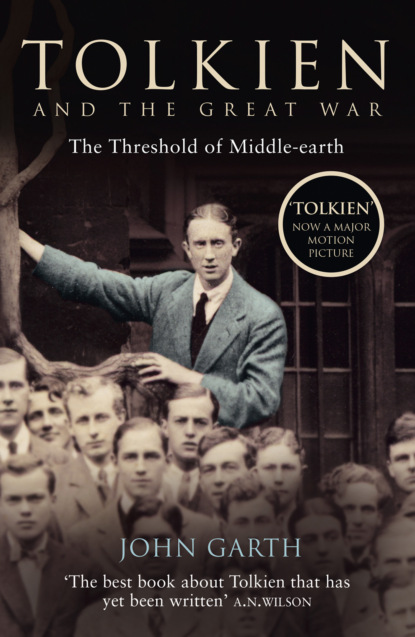По всем вопросам обращайтесь на: info@litportal.ru
(©) 2003-2024.
✖
Tolkien and the Great War: The Threshold of Middle-earth
Настройки чтения
Размер шрифта
Высота строк
Поля
And wind that has been blowing through the stars
Comes to nestle in its tossing draperies.
It is a white tower builded in the Twilit Isles
Where Evening sits for ever in the shade;
It glimmers like a spike of lonely pearl
That mirrors beams forlorn and lights that fade;
And sea goes washing round the dark rock where it stands,
And fairy boats go by to gloaming lands
All piled and twinkling in the gloom
With hoarded sparks of orient fire
That divers won in waters of the unknown sun:
And, maybe, ‘tis a throbbing silver lyre
Or voices of grey sailors echo up,
Afloat among the shadows of the world
In oarless shallop and with canvas furled,
For often seems there ring of feet, or song,
Or twilit twinkle of a trembling gong.—
O! happy mariners upon a journey long
To those great portals on the Western shores
Where, far away, constellate fountains leap,
And dashed against Night’s dragon-headed doors
In foam of stars fall sparkling in the deep.
While I, alone, look out behind the moon
From in my white and windy tower,
Ye bide no moment and await no hour,
But chanting snatches of a secret tune
Go through the shadows and the dangerous seas
Past sunless lands to fairy leas,
Where stars upon the jacinth wall of space
Do tangle, burst, and interlace.
Ye follow Eärendel through the West –
The Shining Mariner – to islands blest,
While only from beyond that sombre rim
A wind returns to stir these crystal panes,
And murmur magically of golden rains
That fall for ever in those spaces dim.
These last lines, in which a hint of paradise is borne on the air through intervening rains, read almost like a premonition of Elvenhome as it is seen at the end of The Lord of the Rings:
And the ship went out into the High Sea and passed on into the West, until at last on a night of rain Frodo smelled a sweet fragrance on the air and heard the sound of singing that came over the water. And then it seemed to him that…the grey rain-curtain turned all to silver glass and was rolled back, and he beheld white shores and beyond them a far green country under a swift sunrise.
It is remarkable to see such a moment of vision, or partial vision, established decades before Tolkien’s epic romance was written.
On the other hand, in the context of what he had put in writing by July 1915, ‘The Happy Mariners’ (#litres_trial_promo) contains many apparent enigmas. Some of these are only explicable with the help of the first fully-fledged prose form of Tolkien’s mythology, ‘The Book of Lost Tales’. Its introductory narrative, written in the winter of 1916-17, mentions ‘the Sleeper in the Tower of Pearl that stands far out to west in the Twilit Isles’, who was awoken when one of Eärendel’s companions in the voyage to Kôr sounded a great gong. Further details resurface in a passage written during the two years after the Great War. Then, the world would be visualized as a flat disc surrounded by the deep blue ‘Wall of Things’. The Moon and Sun would pass this wall in their diurnal courses through the basalt Door of Night, carved with great dragon-shapes. The ‘sparks of orient fire’ won by divers ‘in waters of the unknown sun’ would be explained as the ancient sunlight scattered during attempts to pilot the new-born Sun beneath the roots of the world at night. As Christopher Tolkien notes, ‘The Happy Mariners’ was apparently the song of the Sleeper in the Tower of Pearl mentioned in the same passage.
But the story of the Sleeper was never developed, and at this early stage it is not at all clear that Tolkien himself knew exactly what place his images might take within his mythology, any more than he had known exactly who Eärendel was when he first wrote about him. It is possible that in ‘The Happy Mariners’ these details are seen at the time of their first emergence into his consciousness and that he then set about ‘discovering’ their significance.
Eärendel’s poetic function here is quite different to what it was in ‘The Voyage of Éarendel the Evening Star’, written ten months earlier. Then, Tolkien had celebrated the star-mariner’s daring twilight flight, and the poem had followed him across the night sky. But the speaker in ‘The Happy Mariners’ is apparently confined in this tower and cannot sail in Eärendel’s wake; the twilight is a paralysing veil. Perhaps these differences of viewpoint reflect the change in Tolkien’s own situation and mood between defying the rush to arms in 1914 and committing himself now, in 1915, as a soldier. Read this way, the statement that the enviable mariners ‘bide no moment and await no hour’ looks less opaque, implying that Tolkien, as he began training for war, voiced some of his own anxiety about the future through the figure in the tower of pearl.
The war had now been raging for a year, claiming up to 131,000 British and five million European lives; and there was stalemate on the Western Front, where Germany had just added the flame-thrower to the arsenal of new technologies. Parallels between Tolkien’s life and his art are debatable, but the war certainly had a practical impact on him as a writer. Newly bound to military duty, and with the prospect of battle growing suddenly more real, he took action to bring his poetry to light.
Вы ознакомились с фрагментом книги.
Приобретайте полный текст книги у нашего партнера:
Приобретайте полный текст книги у нашего партнера:





